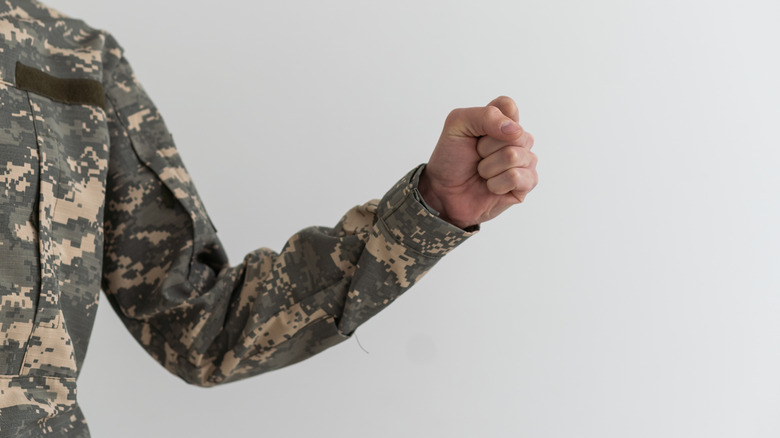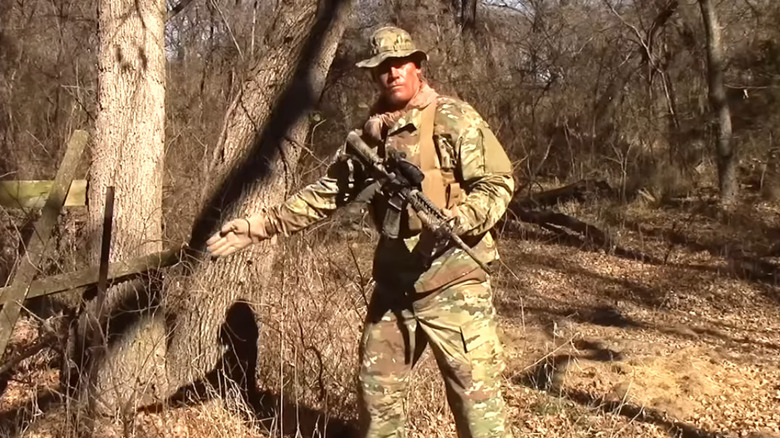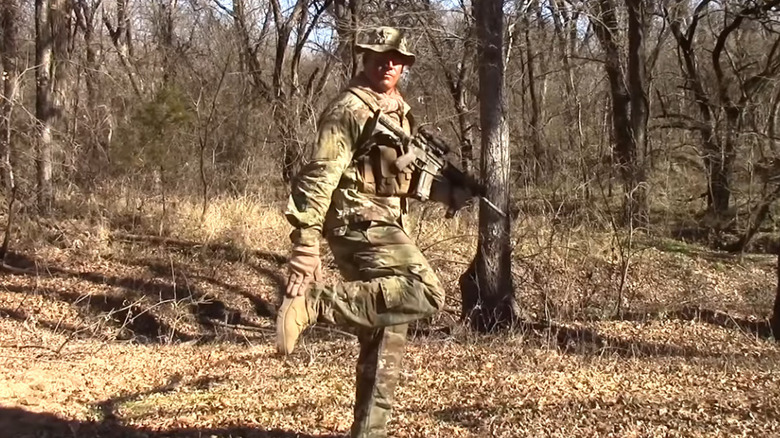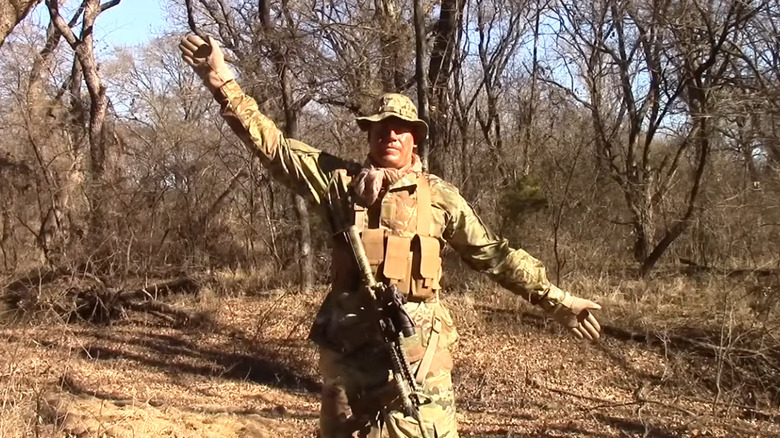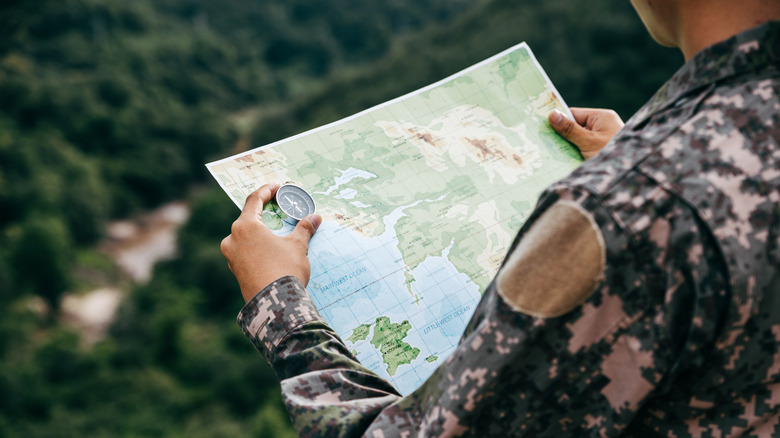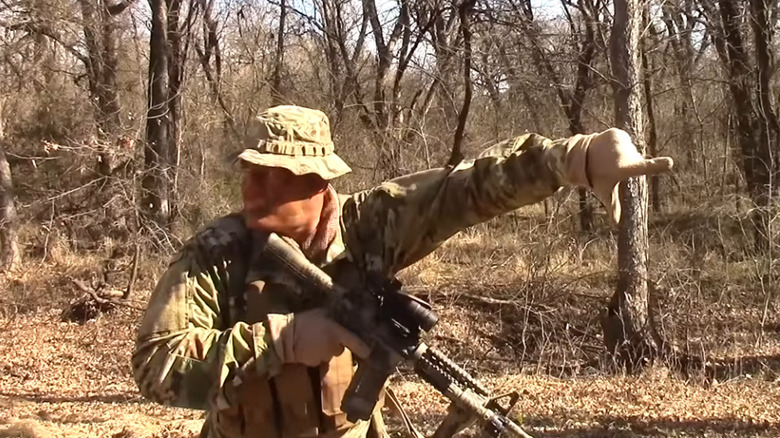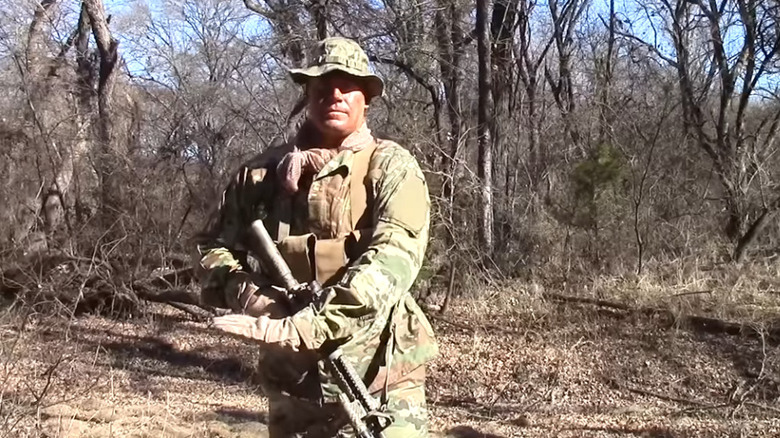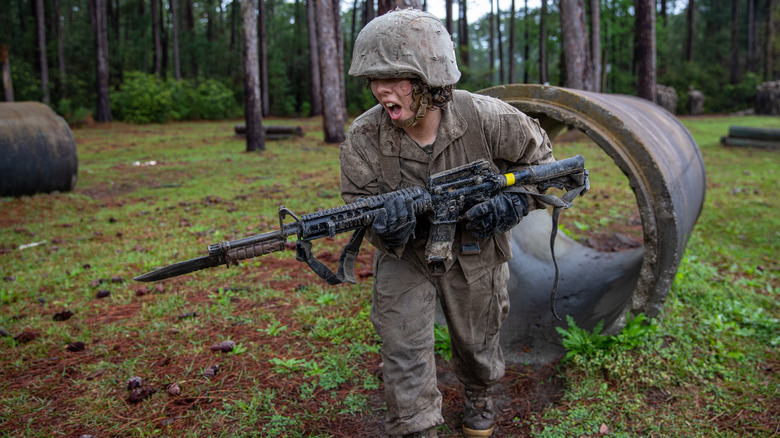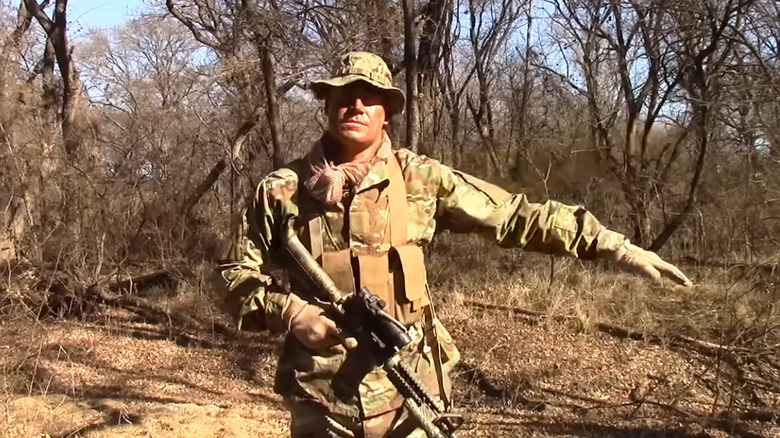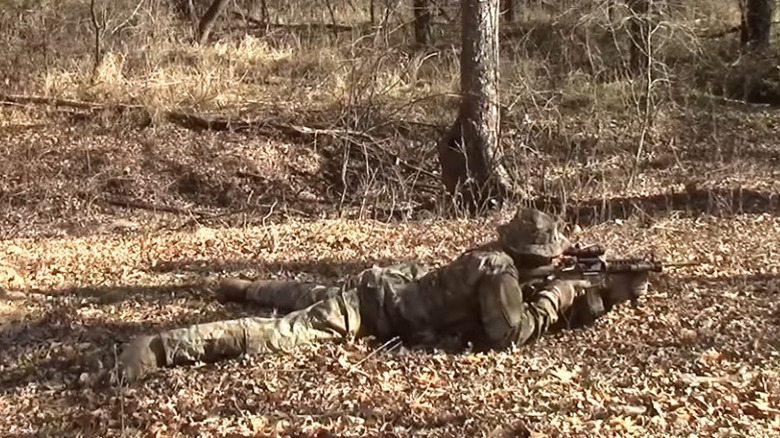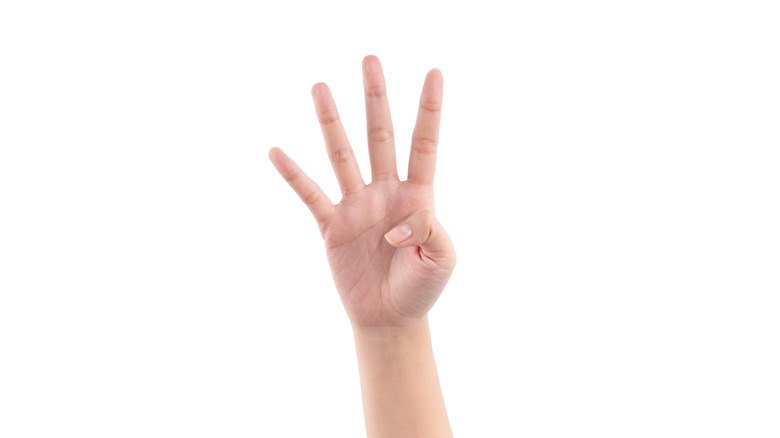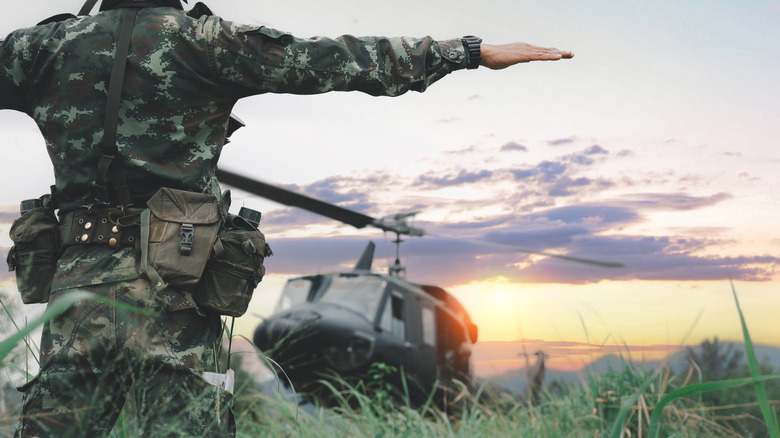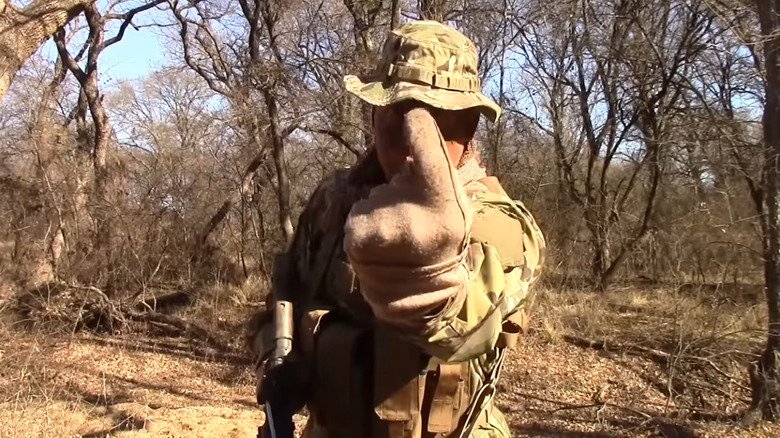12 Common Military Hand Signals (And What They Mean)
If you could choose only two things as a staple of any war movie, they'd probably be military jargon (like "roger" in military aviation) and hand signals. Whether it's Easy Company deep behind enemy lines in "Band of Brothers," or Task Force Ranger besieged in Mogadishu in "Black Hawk Down," soldiers often flash each other their own variety of sign language in quiet, tense situations where words won't do. It never gets old watching a squad of soldiers stacking up on a door and making brusque hand motions before breaching that communicate entire sentences of careful tactical orders. Some of it's pretty obvious by context (like common motorcycle hand signals out on the road), but the majority probably goes over the average viewer's head (like, what does a biker pointing two fingers up mean?).
This military sign language is standardized as visual signals and may vary from one branch of the armed forces to another. To keep things simple, we'll be referencing the U.S. Army's 2017 Visual Signals manual. In each section, we'll break up different types of standard signals for various situations. Many of these signals have been around for a long time, as far back as World War II, but the vocabulary has expanded ever since. Remember that this is a limited, generalized set of signals, and there are many more. Without further ado, here are 12 common military hand signals you might have seen in the movies, and what they mean.
Signal to assemble, rally, or disperse
Soldiers can quickly get spread out over large areas while on patrol or in a convoy, so we'll start with the most basic hand signals: gathering together and dispersing. According to our Army visual signals guide, leaders can signal to group back together (known as assemble or rally) by raising one arm straight up in the air with the palm facing forward, and then making circles. The picture above shows a similar signal, but flipped to point downward, directly at the spot. The person making the signal may point to the specified gathering place for greater clarification.
Getting the attention of just one person is different. To signal one person to come over to you, make a beckoning motion by extending your arm forward (palm up), fingers straight, and bringing it in. Since this is the military, soldiers can't just wave someone over the way they're used to. It lacks discipline and training, for one, and could also be confused with another sign.
On the opposite end of the spectrum, we have disperse. This one starts with your arm raised horizontally, your hand flat (palm down), and your thumb to your opposite shoulder, then sweeping it around to full extension. In both cases, the signal can be repeated as many times as needed.
Speed-related signals
When you're carrying 90 to 140 pounds of gear as a soldier, controlling your pace is vital. Too slow, and you might not reach the objective in time. Too fast, and you'll run out of energy to fight. There are several signals for controlling speed and getting a feel for how fast soldiers are moving. If the leader wants to increase the speed, per the Army visual signals guide, they pump their fist up and down, from the elbow at midriff level, up to full extension. They repeat this vigorously to express the desired speed change.
Quick time (a faster marching speed) is signaled by holding your arm out horizontally with your palm facing forward and then waving it up and down while keeping it straight. This is an example of how easily similar signals can be confused. The signal for taking cover is similar, with the main difference being the direction of the palm.
At any time, the leader might lift their foot backward and tap the heel multiple times to request a pace count. If the leader wants to stop progress entirely, they signal everyone to halt by raising their arm to the square, palm forward, fingers and thumb extended. With the arm in the same position, the signaler can tell soldiers to freeze in place by making a fist.
Formation signals
Formation is the bread and butter of the military, regardless of branch. Just as the Navy's Blue Angel flying team needs to exercise great discipline with how they are arranged, so must a unit of unmounted infantry. Basic formation arrangements can be signaled with hand gestures. To organize everyone into a wedge formation, the signaler either makes a Y shape by lowering their hands beneath the waist and holding them out at 45-degree angles, or they make a rock-and-roll symbol — index and pinky finger extended, with the thumb holding down the middle and ring finger — pointed downward. For a line formation, the signaler holds their arms out horizontally.
Echelon formation, when units will move in a diagonal line, can be signaled by holding one arm straight up at a 45-degree angle and the other down at a 45-degree angle, with both hands flat and fingers pointed out. The right arm is the high one for echelon left, while a raised left arm signals echelon right.
Columns are signaled by raising the hand at 45 degrees and waving it in until the elbow is bent with the hand over the head, repeating — and if the signaler has a weapon in hand, they do it one-handed. A call for a staggered column formation is made with both hands, elbows bent, arms at the square, raised up to full extension, and then repeated. Lastly, the herringbone formation can be made with both arms up at a square, then waved down to horizontal repeatedly.
Signal for map check and SLLS
If the squad has stopped and needs to reorient, the signaler can ask someone to check the map by holding their palm up, elbow bent in, and pointing with the other index finger straight down into the palm. A break for a map check might also be a good time to do a headcount. For that, the signaler reaches their hand behind their head and taps the back of their helmet.
There's even a specific signal for the military concept of SLLS, or stop, look, listen, smell. The signaler makes this sign by doing a sort of listening gesture, bringing one arm up, palm flat out and facing forward at the side of the head, and holding it. SLLS is exactly what it sounds like. You're using all of your senses to observe the situation and make sure nothing is amiss. SLLS is standard procedure after leaving friendly territory, but it's good practice to do it periodically throughout an operation to make sure soldiers are staying on their toes and remaining alert. In fact, SLLS has gained popularity outside the military in the self-help sphere as a sort of focus and grounding technique.
Signal for danger close, enemy sightings, and contact
In war films, most people know instinctively that soldiers will shout contact anytime they see the enemy. To be clear, however, contact doesn't just mean getting a visual on an enemy within firing range, but also beginning to engage with the enemy. To make sure everyone knows where the enemy is so they can maneuver, contact is signaled with either arm to show which direction it's coming from. So for signaling contact right, a soldier raises their arm to the square and brings it down to horizontal, aiming in that direction, and vice versa.
Soldiers have other options if the enemy has been spotted before hostilities have commenced. To direct their brothers in arms to an enemy in sight, they can either point with their rifle leveled and ready to fire, or point with their index finger, thumb pointed down, directly at the enemy. If no enemy is in sight, but soldiers are in an area that's likely dangerous, they can preempt this with a sort of danger-close gesture. They pantomime cutting their own throat with a downward 45-degree motion. Notice that all of these actions are signaled with a single hand to allow soldiers always to have at least one hand on their rifle. It follows the same logic as the tactical reason why military personnel wear watches on the inside of their wrists.
Signals while under attack
Once soldiers are attacked, the bullets might come flying from more than just other ground infantry. A whole subset of signals comes into play for attacks of different kinds, and from other fronts. For example, tactics will change drastically if soldiers come under fire from self-propelled artillery and tanks. If enemy choppers are coming in hot, soldiers can signal that an air attack has begun. To do so, a soldier raises their arms with the elbows slightly crooked and bends them inward until they cross, repeatedly.
In rare situations, soldiers may come under attack from chemical or biological weapons, or perhaps even a nuclear attack. For any of the former, the soldier puts their arms out almost horizontally and makes fists. Then they bring them in to the head, and repeat.
At this point, the leader may decide it's time to open fire. To signal to commence firing, the leader faces their palm down to the ground, keeping it low and making a horizontal sweeping motion in front of their waist. Speeding up or slowing down this sweeping motion signals to a machine gunner to up their rate of fire. The signaler can also indicate to the gunner to change their direction or elevation by counting in increments from one to five with one of their hands, signaling left or right, up and down, respectively. For numbers larger than five, the signaler can repeat the motion multiple times to change direction or elevation.
Signal to fix bayonets
Bayonets have been a staple of infantry action since the 17th century, and the U.S. military still uses them to this day. There was a bayonet charge during the Iraq invasion, believe it or not. Even amidst unbelievably high-tech military weapons like railguns and hypersonic missiles, the simplicity of what is effectively a polearm on a rifle can't be beat in close-quarters combat. Although bayonets do factor into modern warfare less often than they used to, there is still a simple, standardized gesture to tell soldiers to fix bayonets when the need arises.
The fix bayonets signal is literally pantomiming the action of fixing a bayonet. With the rifle held by the front end, butt-down on the ground, a soldier makes a fist, pretends to remove a bayonet from its scabbard, then brings it around to mount it to the weapon's barrel. The fact that this is in a relatively recent military handbook at all is evidence enough that today's soldiers know their way around bayonets. However, bayonets rarely see action, even in modern training.
Signal to take cover
Contrary to what Hollywood often depicts, warfare is not as flashy as it might seem. It's a lot less soldiers in constant, tense, close-quarters firefights, and a lot more sporadic battles of attrition where combatants keep to environmental cover and pick off the enemy one by one while trying to maneuver, sometimes over the course of weeks or months. Soldiers need to take cover frequently, wherever they can, and the signal for doing so is one they may see quite often. The signaler raises their arm up at 45 degrees, palm down, and drops it.
While behind cover, soldiers will take sporadic shots at the enemy beyond. If leadership wants them to stop, the cease firing gesture is made. You've probably seen it in "Saving Private Ryan" when Tom Sizemore makes it during the invasion of Normandy. The signaler puts their hand in front of their face, palm outwards, and waves it up and down while keeping the elbow in the same position. If a soldier has been injured or killed during one of these enemy encounters, someone can make the signal for out of action by punching an open palm in front of them several times.
Signals to take a knee or go prone
If there is no cover or the cover is poor, then the best course of action is for soldiers to lower their profile by getting down. Even when no enemy has been sighted or no danger is near, the leader may signal the men to take a knee so they can rest while still being battle-ready, smaller targets in the event crap hits the fan. First, the signaler must have already given the command to halt — raising an arm to the square with the fingers extended — after which they must put out their arm at a low angle near the waist, palm down and horizontal to the earth, to signal soldiers to lower themselves to one knee.
From this position on a knee, the signaler can further signal the men to hit the deck. With their hand in the same position as it was for taking a knee, they bend it up at the elbow and make a down-swatting motion to tell the soldiers to go prone. Going prone is one of the best positions to be in during a combat scenario, since it makes a soldier less visible (and thus a harder target to hit when spotted) while also increasing accuracy and making it less likely they'll be hit.
Number signals
If you've tried learning ASL via the Duolingo app or its alternatives, you might think some of those basic hand signs translate over to the military. They don't, at least not completely. For example, the hand signs for numbers in sign language alternate between using the thumb for the first five numbers, then pinching fingers together for six through nine until making a thumb-and-wrist gesture for ten — and of course, these may vary depending on which dialect of sign language you're using. For military number hand signals, things are simpler. The signaler starts with the index finger, counting to five with the first four fingers and ending with the thumb.
The hand is turned sideways for six through nine, and the signaler again starts from the index finger down to the pinky. Instead of a sign for 10, the hand is made into a fist for a zero, and numbers are combined to make larger ones. For example, if you wanted to say 19, you would simply make the sign for one followed by nine. Since military contexts will focus on simple double-digit and triple-digit numbers like the number of people, lengths of distance, or amounts of time, there is limited need for higher or more complex numbers and signs.
Emergency signals
Disaster strikes especially hard on the battlefield where everything can go wrong in the blink of an eye. When these sorts of life and death situations crop up, the army has a rare set of signals to handle them. Soldiers may often need to make signals that are visible from above by friendly air support, for example.
Soldiers can lie supine on the ground with their hands extended straight above their heads to ask for medical assistance. They can ask for a pickup by standing with their hands raised straight up or tell an approaching helicopter to land at a certain spot by squatting and reaching their hands straight forward. Basic responses to questions with the affirmative or negative can be signaled, too. One hand forward, making a complete arc top-to-bottom, means yes, and waving it side to side like a pendulum means no. Likewise, soldiers can warn approaching aircraft. Waving hands back and forth above their head means pilots shouldn't land in the area.
If they need a more permanent signal for any passing aircraft, they can also make a series of symbols on the ground with whatever they have available — rocks, dirt, equipment, and so on. For example, making a symbol like the Roman numeral for two (II) says they need medical supplies, while a single jot (I) means a doctor is required for a serious injury. A triangle signals a safe landing area, and an "F" is a request for food and water. There are many more, including mirror and strobe signals, but we'll leave it at that.
Signals for communications and leadership
The military is a strict hierarchy with each man being assigned a specific duty or specialty. A clutch of hand signals allow the signaler to get the attention of one specific person and send basic commands. For example, leadership can hail the radio operator by making a telephone gesture near their mouth.
In the army visual signals manual, we find a handful of signals for signaling leaders of platoons and squads. Pointing the index finger up and putting it right in front of the eyes tells the platoon leader to move up. Grabbing your collar (or grabbing an imaginary one) does the same for a platoon sergeant.
In some cases, a group of soldiers may have multiple squads. The leader for each can be signaled by making the number of that squad and placing it on the opposite biceps. Those respective leaders can signal that they have acknowledged the message by giving a thumbs-up. As mentioned, other signals can be used here, depending on the branch of the military and the soldier's training. Simply crooking your finger and beckoning the old-fashioned way will get someone forward who might be too green to recognize other signs automatically.
